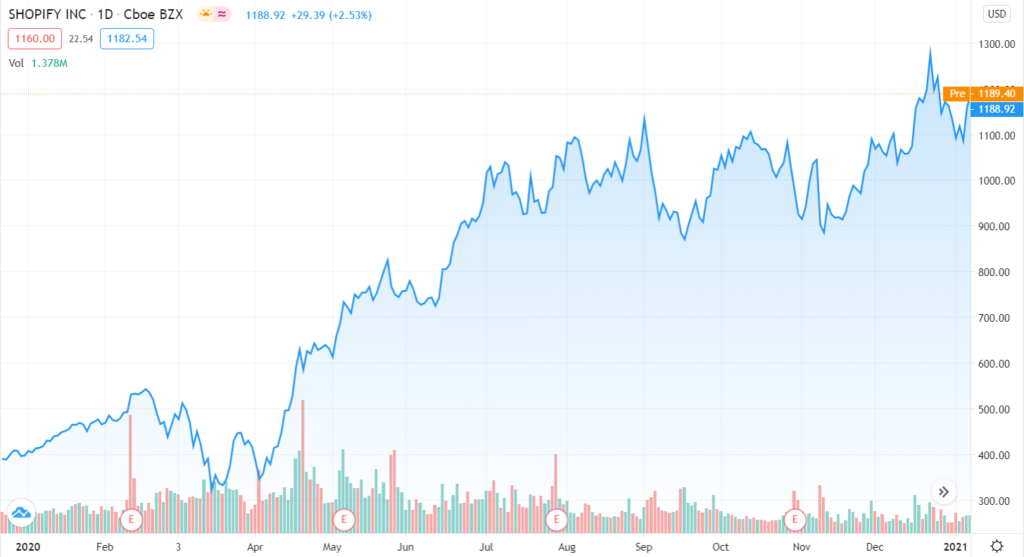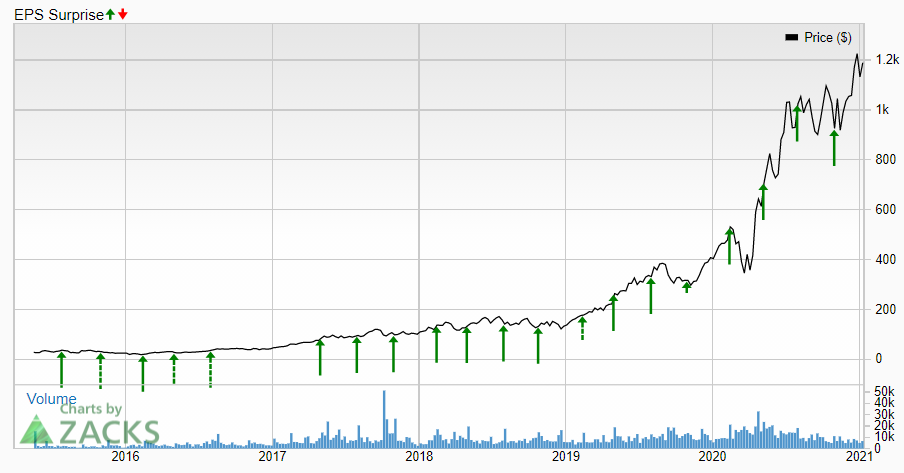While the pandemic has devastated countless businesses, it has provided a major boon for eCommerce platform Shopify.
Shopify’s stock had a great year. According to the research data analyzed and published by Finnish site Sijoitusrahastot, it rallied by 169.9% in 2020, compared to industry-wide growth of 26.6%.
Since it went public in 2015, Shopify’s stock has maintained a remarkable uptrend, rising over 40-fold to over $1,200 at the end of December 2020. Between 2016 and 2019, it surged by over 1,400%. As of mid-December 2020, the stock had a 90 RS rating, which means that it outperformed 90% of stocks over the year.

During the first three quarters of 2020, Shopify’s eCommerce earnings grew at an average of 552%. That was well above the 101% three-year average. Its sales grew by an average of 57% over the previous three-year period.
At the end of its third quarter on October 30, 2020, the company outperformed revenue and earnings estimates for the three-month period. Its revenue nearly doubled from $390.6 million to $767.4 million, against an expected $663.1 million. Compared to Q3 2019, that was a 96% spike.
As the third eCommerce platform in the world, Shopify attained a total of $522 million for its merchant solutions. On the other hand, its subscription revenue from new merchants joining the services accounted for $245 million.
Its earnings rose from a net loss of 29 cents per share to $1.13 per share. Similarly, its Gross Merchandise Volume (GMV) soared by 109% reaching $30.9 billion, against an expected $27.46 billion. To provide some perspective, Shopify’s GMV grew by 46% in Q1 2020 and 119% in Q2. At the end of the third quarter, Shopify declined to provide an outlook for Q4 2020.
For the first nine months of 2020, its revenue shot up by 82% year-over-year (YoY). In the same period, its adjusted net profit was $292 million, in comparison to a net loss of $16 million in the prior year period. At the end of Q3 2020, its cash, cash equivalents and securities totaled $6.12 billion, up by 149% from the previous year.
Notably though, $3.49 out of the total came from debt and share offerings that took place in Q2 and Q3. With the exclusion of that amount, the figure grew by 9%.
Shopify Holds 6% Share of the US eCommerce Market
According to the Zacks Consensus Estimate, analysts project its Q4 2020 earnings per share (EPS) to jump by 188.37% to $1.24. Moreover, they estimate a sales increase of 78% for the three-month period, reaching $899.2 million.
Zacks analysts project that for the full year 2020, Shopify’s EPS will skyrocket a momentous 1,137%. However, they predict a 5% decline in 2021.

During the year, Shopify demonstrated that it is a potent threat to Amazon and eBay’s eCommerce dominance. For the first time, Shopify’s GMV surpassed that of eBay in Q2 2020. It repeated the feat in Q3 when eBay reported $25 billion as GMV.
Based on its estimates, Shopify now has a 6% share of the eCommerce market in the US. That is higher than eBay’s, Walmart’s and Apple’s but still a small fraction of Amazon’s 37%.
Shopify Merchants Sell Over $5.1 Billion on Black Friday, Cyber Monday
2020’s Black Friday to Cyber Monday shopping bonanza saw merchants on Shopify sell goods worth more than $5.1 billion. For Black Friday alone, total sales amounted to $2.4 billion, up by 75% from the 2019 figure.
Compared to 2019 when the GMV amounted to $2.9 billion, the weekend’s total marked a 76% uptick. It also set a new record for the eCommerce service. There were more than a million merchants over that weekend, mostly consisting of small and independent brands. They sold to over 44 million buyers, 50% higher than the shoppers seen in 2019.
Since 2017, Shopify has seen a five-fold increase in its Black Friday to Cyber Monday sales, from about $1 billion. Its top-selling countries included the US, Canada and the UK. It generated triple-digit sales growth in four markets, namely, the UK, Italy, Japan and Germany.
The best-performing segment was apparel and accessories. Health and beauty products came in second while home and garden products ranked third. Slightly more than two-thirds of all orders were placed using mobile devices, almost equivalent to the 2019 figure.
For comparison purposes, independent businesses selling on Amazon generated $4.8 billion in global sales through the same weekend. Compared to 2019, the figure was up 60%.
Shopify’s small retailers thus surpassed Amazon’s by a remarkable $300 million. Amazon did not reveal its total sales figure for the weekend. However, it said that the 2020 holiday shopping period had been the biggest in its history.
Source: https://sijoitusrahastot.org/
















